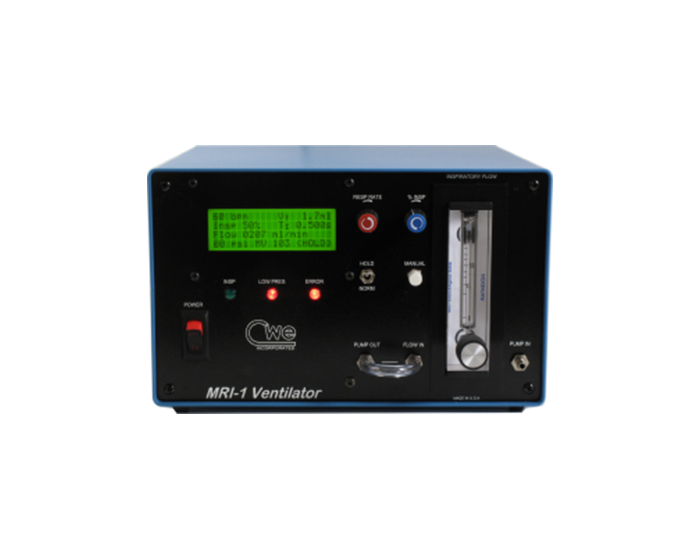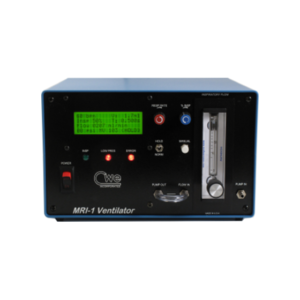MRI-1 Ventilator

The MRI-1 Ventilator is a small animal ventilator designed for use in MRI and other high magnetic field environ- ments. The system comprises a microprocessor-based con- trol unit and a set of remote, pneumatically operated, non- metallic valves. The MRI-1 can operate by itself or can be controlled and/or monitored by a computer.
Features
- Non-magnetic pneumatic valves
- Dependable all-electronic ventilator
- Wide tidal volume and rate range
- Mice to Guinea pig size
- Safe with oxygen and anesthesia
- Direct readout of volume and rate
Description
The MRI-1 operates on the flow-time principle: an inspira- tory airflow is established and gated into the animal for a known time, thus producing a known volume. This approach provides extraordinary flexibility — a wide range of volumes, breaths-per-minute, and I/E ratios are possible with no hard- ware changes, and using just three front-panel controls.
Respiratory airflow is provided by an internal airpump. Alternatively, an external pressurized gas source can be attached (oxygen or anesthetic gasses).
The remote high-speed, miniature pneumatic valves do the actual airflow switching. By locating these valves close to the animal (including inside the magnet bore if necessary), dead-space and tubing compliance are minimized.
Operation
Setting up and operating the MRI-1 is easy. Two lengths of flexible tubing connect the control unit and the valves; one supplies the inspiratory airflow and the other is the pressure source for operating the valves. Only three controls are required: RESPIRATORY RATE is set in breaths/minute; the FLOW RATE is set using the front-panel flowmeter (and measured
internally by a mass flowmeter); and the PERCENT INSPIRATION is set to establish the ratio of inspiration to expiration time (I/E ratio). All respiratory parameters are shown on the front-panel LCD display. The tidal volume and minute ventilation reflecting the current settings is also continuously displayed, and can easily be changed by adjusting the FLOW RATE.
Expandable
Of course, the MRI-1 can also be used in other than mag- netic environments. Because of the non-electrical nature of the ventilation valves, this unit is particularly well suited to sensitive electrophysiology recording situations. Besides the standard miniature pneumatic valves, the MRI-1 accepts any of the valve assemblies available for the popular SAR-830 series ventilators. Using the MVA-4 multi-valve expander, it is also possible to ventilate several rodent-sized animals simul- taneously using just one MRI-1 as the control unit. The exter- nal valves operate synchronously, but tidal volumes are inde- pendently set by varying the flow rate to each valve assembly.
A source of compressed air or helium is required for oper- ating the pneumatic valves. This is attached to the rear panel of the unit, and the pressure is internally switched on or off as required for remote valve operation. Helium is often used as the actuating gas because its lower density and viscosity per- mits somewhat faster valve switching. All models feature switchable 120/240VAC operation.
Specs
Articles
Software
FAQ's
What we are about
Xperiment Girl’s past was shrouded in mystery until now. Xperiment Girl was originally the international respected Dr. Gene Knockout researcher extraordinaire, a living legend working out of her hidden Nerve Center at IITC. For most of her career, Xperiment Girl worked with inferior equipment resulting in bad data.
Teaching the fine art of mastering and measuring accurately tail cuff blood pressure on mice, rats and all other animals, Xperiment Girl in turn intrigued by pain and how she could assist in superior equipment in the field of pain tolerance, fascination/became obsessed with solving poor test data from inferior equipment. Continue reading...
- IITC Inc./Life Science
- 23924 Victory Blvd.
- Woodland Hills, CA 91367 US
- 818-710-8843



